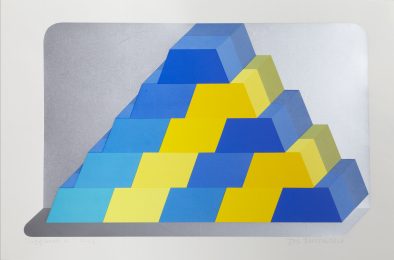

Joe Tilson was born in London in 1928 and is a British visual artist, painter, sculptor and engraver belonging to the Pop Art movement, which he joined since its early beginnings in London. He is renowned for his wooden reliefs thanks to his knowledge of carpentry, making use of usually flat and very bright colours, which are typical of the Pop Art movement. His works are reminiscent of children’s toys because of their construction and schematisation. In his paintings, he also links spaces with emblematic images, famous people and letters. From 1944 to 1946 he was working as a carpenter and he later used this knowledge to serve in the Royal Air Force until 1949. His artistic career began that same year.
Joe Tilson enrolled at St Martin’s School of Art under the guidance of Leon Kossof and Frank Auerbach, where he stayed until 1952. Then he went on to study at the Royal College of Art with Peter Blake and Richard Smith. After receiving the Gulbenkian Foundation Prize in 1960, Tilson sharpened and formalised his abstract language in less than two years, and he was the first artist to get an individual exhibition at the Marlborough Gallery in London. After his involvement with Pop Art, which culminated in a series of political-themed works called ‘Pages’ (1970), Joe Tilson returned to traditional wood crafts and the symbolism of the four elements. From then on, he took a completely different direction because of his deep dissatisfaction with the technological and industrial progress of modern society.